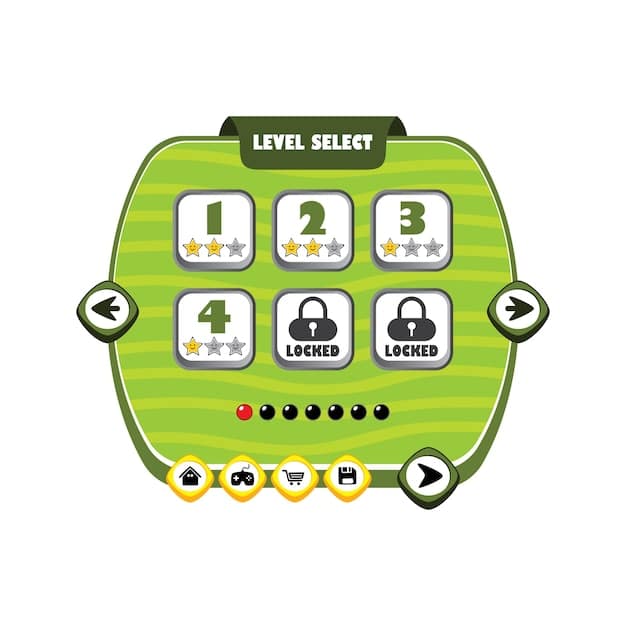Console Gaming Accessibility: Customize Settings for an Inclusive Experience

Console gaming accessibility involves customizing settings like controller mapping, display options, and audio cues to create a more inclusive and enjoyable experience for players with disabilities, ensuring everyone can participate and have fun.
Console gaming has evolved into a diverse and immersive entertainment platform, but ensuring console gaming accessibility: customize your settings for a more inclusive experience is essential for players with disabilities. Adjusting settings can open up worlds of fun for everyone.
Understanding Console Gaming Accessibility
Console gaming accessibility is about making video games playable and enjoyable for individuals with disabilities. Different consoles offer a range of accessibility settings that can be customized to meet varying needs. Let’s explore it deeply.
Why Accessibility Matters
Accessibility is important because it allows more people to enjoy gaming. By accommodating different needs, the industry promotes inclusivity and diversity.
- Accessibility improves the gaming experience for everyone.
- It allows people with disabilities to participate and engage.
- Inclusive design can lead to more innovative and enjoyable games.
Common Accessibility Barriers
Many common barriers can prevent people with disabilities from enjoying console games. Some may find it hard to use a standard controller, while others may struggle with visual or audio cues.
These barriers include:
- Difficulty with fine motor skills required for complex button combinations.
- Inability to distinguish colors or see small text on the screen.
- Challenges processing fast-paced audio or visual information.
Addressing these barriers is the first step in creating a more inclusive gaming environment. Customizing console settings and using adaptive equipment can help overcome these challenges. By focusing on these accessibility barriers, the gaming experience can be vastly improved for many players.
Understanding the importance of accessibility and addressing common barriers sets the stage for creating a genuinely inclusive gaming environment. The more customizable and adaptable gaming is, the more enjoyable it becomes for everyone.
Customizing Visual Settings for Better Clarity
Visual settings significantly impact the gaming experience. Options like colorblind modes, text scaling, and brightness adjustments can enhance clarity and reduce eye strain. Making these adjustments is key to ensuring a comfortable experience for everyone.

Colorblind Modes
Colorblind modes alter the color palette to help players distinguish between colors they might otherwise struggle with. Many modern consoles offer multiple colorblind modes to cater to different types of color vision deficiency.
These modes include:
- Protanopia mode for red-green colorblindness.
- Deuteranopia mode for another form of red-green colorblindness.
- Tritanopia mode for blue-yellow colorblindness.
Text Scaling and Readability
Adjusting text size and contrast makes in-game text easier to read, especially for players with low vision. Clear communication in games is key, and readable text is essential for understanding instructions, dialogues, and more.
Steps to improve readability might include:
- Increasing the size of subtitles and menu text.
- Changing the font style to a clearer, more readable option.
- Adjusting the background color to improve contrast.
Customizing visual settings can dramatically improve the gaming experience, making it more accessible and enjoyable for people with various visual impairments. Colorblind modes and text scaling ensure that all players can follow the action and understand the game’s narrative. These features demonstrate a commitment to inclusivity and enhance the overall usability of console games.
Audio Customization for an Immersive Experience
Audio customization is crucial for players who are hard of hearing or have auditory processing issues. Volume control, spatial audio settings, and subtitles allow gamers to experience the game fully. Fine-tuning these elements enhances the overall sense of involvement and immersion.
Volume Control and Sound Balance
Adjusting individual sound levels allows players to prioritize important audio cues. Balancing game music, sound effects, and dialogue is simple to do on most consoles.
Considerations for volume control:
- Increase the volume of critical sound effects, like footsteps or alarms.
- Reduce background music to focus on dialogue and important cues.
Subtitles and Closed Captions
Subtitles are critical for understanding the storyline and dialogue. Closed captions provide additional information, such as speaker identification or sound cues, to enhance comprehension.
Subtitles settings include:
- Customizable text size and color.
- Options to enable or disable background boxes for better readability.
Appropriate audio settings are vital to create an immersive gaming experience for players who might otherwise struggle to hear important cues. The ability to adjust volume levels helps focus on crucial sounds, while clear and customizable subtitles ensure no one misses critical narrative details. Implementing these features acknowledges the diverse needs of gamers and enhances the enjoyment of all players.
Controller Mapping and Customization
Controller mapping and customization allows players to reconfigure button layouts. This is extremely useful for individuals with limited mobility or other physical impairments. It promotes comfort and better playability across the board.
Reassigning Buttons
Consoles now typically allow players to remap buttons and triggers to positions that are more convenient. This flexibility promotes an easier and more natural control scheme.
Benefits of reassigning buttons:
- It allows players to use different parts of their hands or fingers.
- It can move critical actions to more accessible buttons.
Adaptive Controllers
Adaptive controllers are designed to be highly customizable and work with various assistive devices. They allow people with significant physical disabilities to control games in ways that weren’t possible before.
Features often include:
- Large, easy-to-press buttons.
- Compatibility with external switches and joysticks.
Controller mapping and customization are essential for ensuring individuals with limited mobility can enjoy console games. The flexibility in reassigning allows players to tailor the control scheme to their unique needs, while adaptive controllers offer advanced solutions for those with significant physical impairments. Addressing these needs demonstrates a real commitment to creating inclusive gaming experiences for everyone.
Difficulty and Game Speed Adjustments
Adjusting game difficulty and speed can make games more accessible for players who are new to gaming, have cognitive disabilities, or prefer a more relaxed experience. Games with adjustable difficulty settings and modes cater to a wider range of skills and preferences.

Choosing the Right Difficulty
Selecting an appropriate difficulty level is crucial for enjoyment. Many games offer multiple difficulty settings, ranging from ‘Easy’ to ‘Very Hard,’ to accommodate different skill levels.
Difficulty options typically affect:
- Enemy health and damage output.
- The frequency of checkpoints.
Game Speed and Reaction Time
Slowing down game speed can provide more time to react to on-screen events. This can be particularly useful for players who have slower reaction times or cognitive challenges.
Adjusting game speed makes play more accessible and often allows:
- More time to consider strategic options.
- Less pressure during fast-paced activities.
Customizing game difficulty and speed is a great way to ensure more people benefit from inclusive options. Selecting an appropriate difficulty level ensures that the game presents a satisfactory challenge without becoming frustrating. Offering slower game speeds also allows time for consideration and action. These adjustments enhance accessibility and can drastically improve game playing for a broader audience.
Utilizing Console Accessibility Features
Consoles come equipped with various built-in accessibility features. These tools are designed to improve the gaming experience for gamers with disabilities. These features include screen readers, voice commands, and dedicated accessibility menus, which can greatly enhance the playability of many games.
Screen Readers and Text-to-Speech
Screen readers audibly narrate on-screen text, allowing gamers with visual impairments to navigate menus and interfaces. Features such as text-to-speech integration allow players to understand written content through spoken words.
Benefits from these features include:
- Enhanced menu navigation.
- Improved comprehension of in-game instructions.
Voice Commands and Navigation
Voice-activated controls allow operators to command the console and control gameplay hands-free. Voice navigation can simplify many tasks and enhance overall user experience.
Use cases for voice controls:
- Opening apps and games.
- Navigating menus and settings.
Console accessibility features offer an array of options designed to vastly improve the gaming experience for users with disabilities. Screen readers and text-to-speech features allow players with visual impairments to access and navigate console interfaces with greater ease. Adding voice command options allows for hands-free interactions, further streamlining control. By leveraging these built-in capabilities, console gaming can become more inclusive and fun for everyone.
| Key Point | Brief Description |
|---|---|
| 🎨 Visual Settings | Adjust colors, text size, and brightness for clearer visuals. |
| 🔊 Audio Customization | Balance sound levels and use subtitles for an immersive audio experience. |
| 🎮 Controller Mapping | Remap buttons and use adaptive controllers for comfortable play. |
| ⚙️ Accessibility Features | Utilize screen readers and voice commands for easier navigation. |
Frequently Asked Questions
▼
Navigate to the console’s settings menu, typically found under ‘Accessibility’ or ‘Display.’ Look for colorblind options, usually offering modes like protanopia, deuteranopia, and tritanopia. Select the mode that best suits your vision.
▼
Adaptive controllers are designed for gamers with limited mobility. They offer customizable button layouts and support various assistive devices. These controllers make gaming more accessible for individuals who struggle with standard controllers.
▼
Subtitles can usually be enabled in the game’s settings menu. If the game does not have a subtitles option, check for console-level settings. Look for ‘Accessibility,’ then ‘Subtitles,’ and customize the text size and color if needed.
▼
Yes, most modern consoles allow for button remapping directly through system settings. This flexibility allows players to reconfigure the controller layout to better suit their individual needs and preferences, making the gaming experience more comfortable.
▼
Accessibility settings are generally located in the console’s main settings menu. Look for options such as ‘Accessibility,’ ‘Ease of Access,’ or similar terms. These menus house all the features designed to enhance gaming for individuals with disabilities.
Conclusion
Customizing accessibility settings on your console can significantly improve the gaming experience for people with disabilities. By utilizing visual, audio, and controller customizations, as well as built-in console features, gaming becomes more inclusive, accessible, and enjoyable for everyone.





